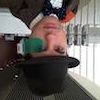It was long time trend even in the 90's to scrap the PC data and archive only the celluloid forms used for print, if the data were in greyscale and last edits were done by cut'n'paste on celluloid.Hujio wrote: So here's the theory --
At least that was the trend in Czech republic and Europe in phototypographic industry. As the technology progressed in 2000's and forms started to be made from PC data to print desks on ofset and digital era took it's reign, it's the trend that we all know about, that we store the digital data in PDF + the graphic who typed the book have it in indesign, quark or tech format for easier edits and also, preservation of the data for later purposes. It's pretty common, that we want to publish really old book which is out of print in our publishing house, but we have only celluloid scans. If the printing plant has the celluloid in archive, we do it oldschool, but for changes, we must do the part from scratch or mostly, we do the whole book from scratch a new in InDesign.
So I think it's the case with Daizenshuu, that they didn't even had the original celluloids, but their scans in PC, or they didn't had any, so they flat-out scanned the book to ease their work and not make it from scratch.
Talk about lazy, but from what I saw, the typography and layout in these books are pain in the ass, so logically, to make it for the movie hype, without having it by new supervision of editors, who must read everything and doing corrections, the did it fastest way possible.
PS: The idea of scrapping the digital data seems absurd nowadays, but making photocopied celluloids from negatives, that were made from PC and later light them on ofset forms was expensive and time consuming as hell, so nobody thought about making the same book again from scratch. As we can light the PC data directly via RIP software and then add it to printing machine, or better! having these machines built into the printing machine, so you copylight the PC data directly into print, it all became so fast and cheap and easy, so that we make edits even as late as minute before printing without any expense.














